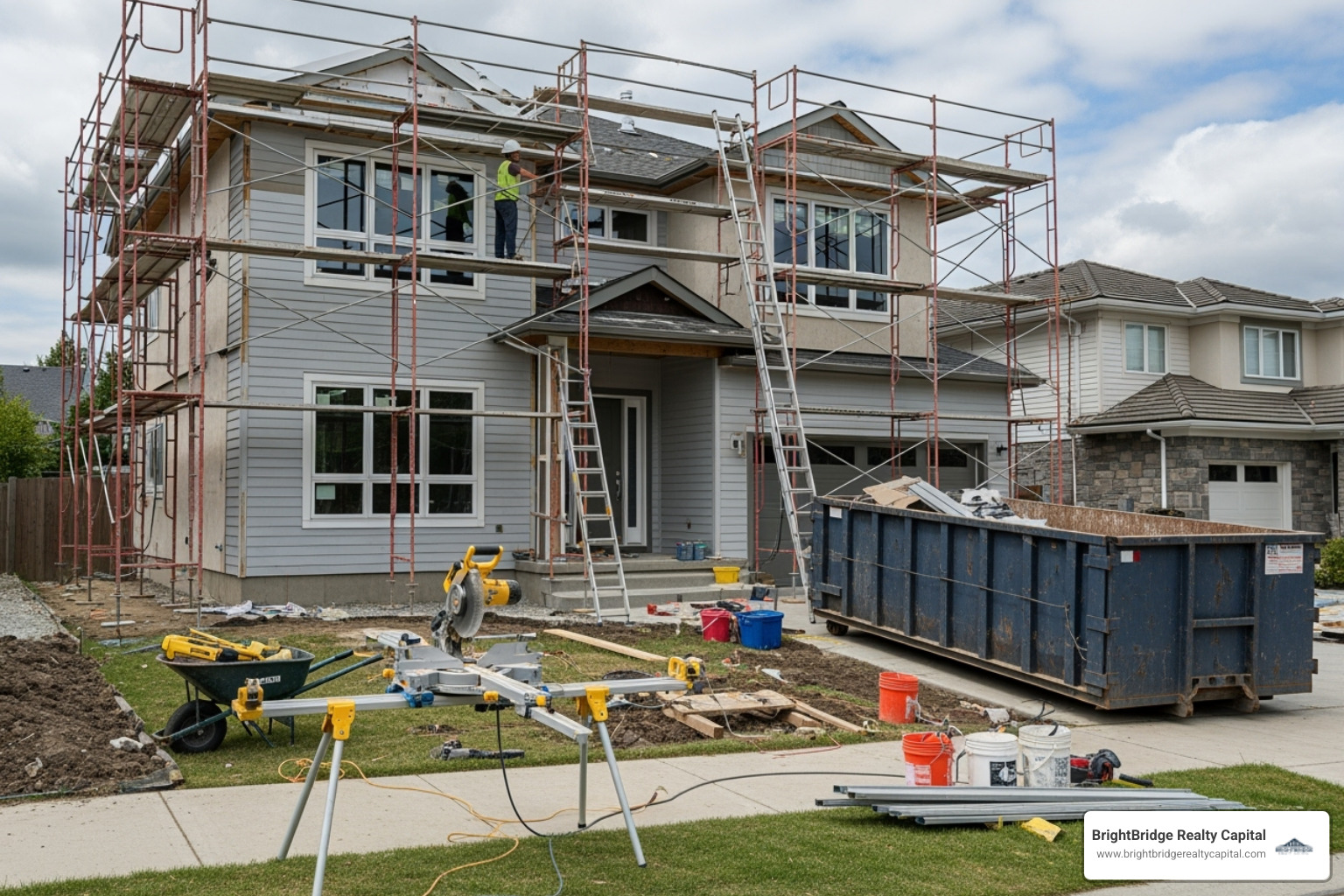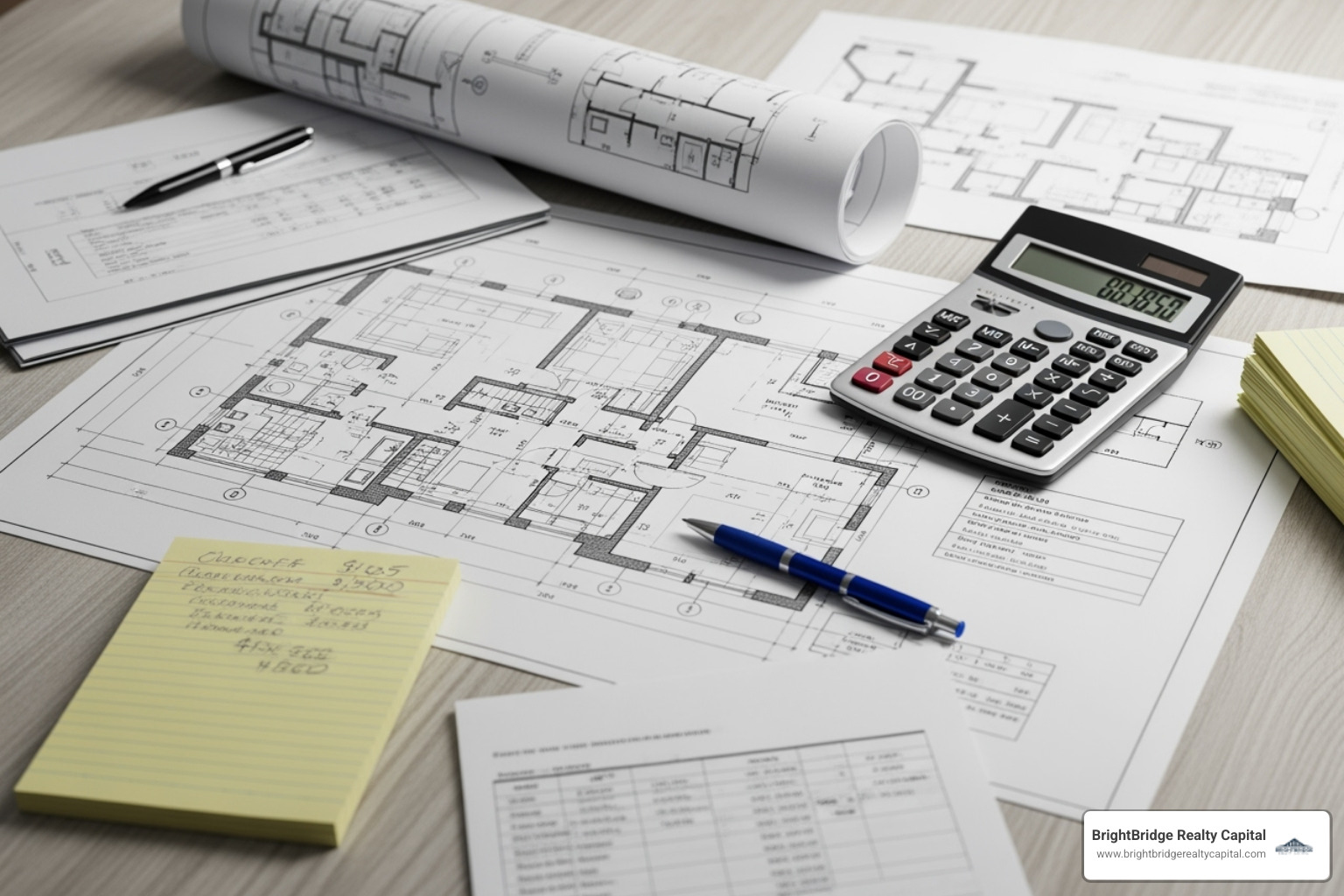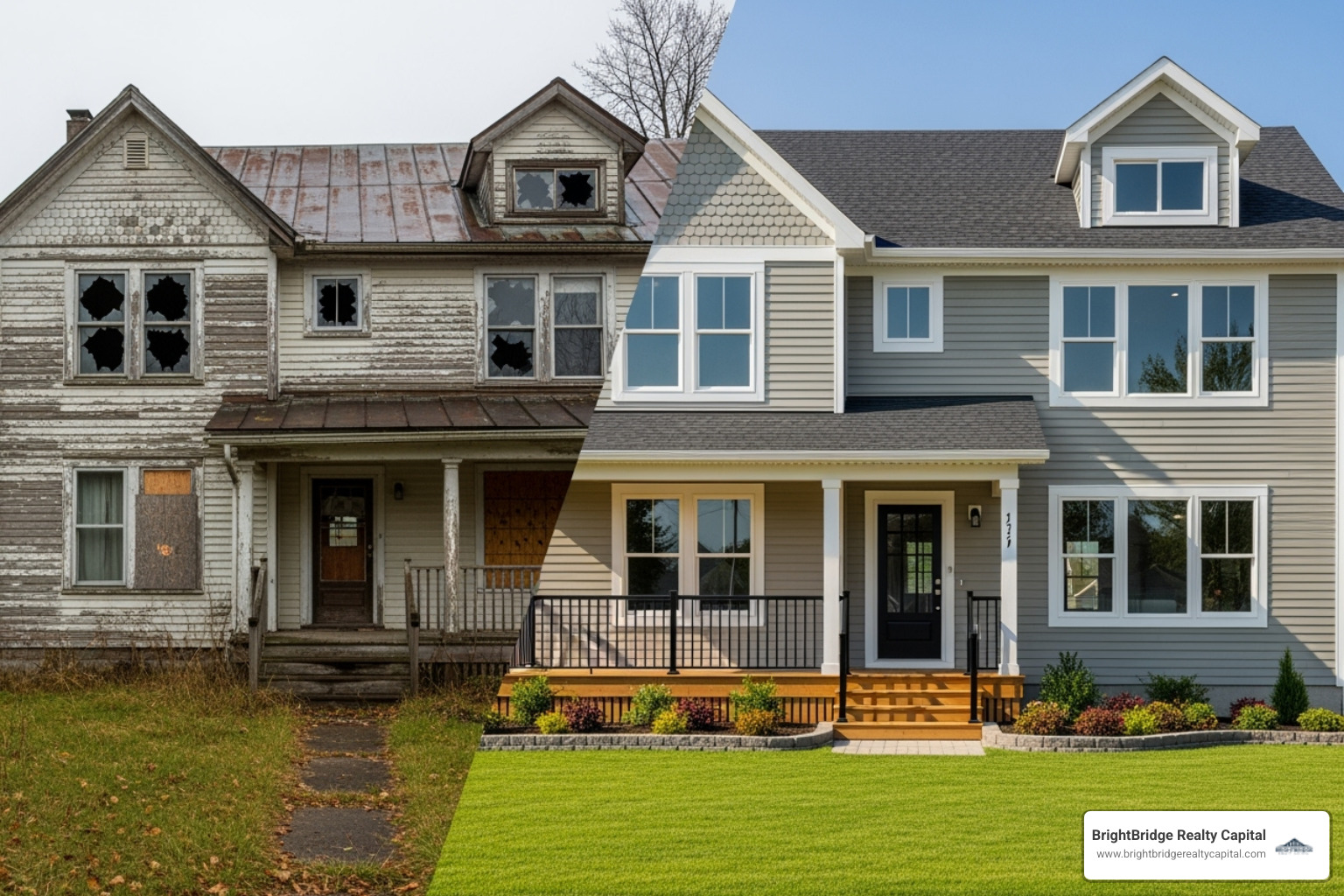Transform Your Property: Using a Bridge Loan for Home Improvements

Why a Bridge Loan for Renovation Makes the Difference in Real Estate Investing
A bridge loan for renovation is a short-term financing solution providing quick capital to purchase and improve properties before securing permanent financing or a sale.
Quick Answer: How to Use a Bridge Loan for Renovation
- Secure the Property - Funds the purchase price (typically up to 75-80% LTV).
- Finance the Renovation - Lenders may fund up to 100% of rehab costs, often released in stages.
- Complete the Project - Renovate within the loan term (usually 6-24 months).
- Execute Exit Strategy - Repay via sale (flip) or refinance into long-term financing.
In competitive markets, properties needing significant work often sell at steep discounts. However, traditional mortgages rarely fund properties in poor condition and take 30-45 days to close. This is where renovation bridge loans become essential, differing from standard mortgages in three critical ways: speed (funding in 5-10 days), flexibility (financing properties traditional lenders won't touch), and structure (rolling renovation costs into the loan).
The typical structure involves borrowing against the property's current value and its projected after-repair value (ARV). Lenders may advance up to 80% of the purchase price and fund up to 100% of verified rehab budgets. Interest is usually paid monthly or rolled into the loan, with the principal due at the end of the term.
At BrightBridge Realty Capital, we help investors structure these loans to move faster, compete with cash buyers, and maximize returns on properties others overlook.

Bridge loan for renovation terms made easy:
Understanding the Fundamentals: What Is a Bridge Loan for Renovation?
When you find a great investment property that needs serious work, traditional lenders often say no, and they move too slowly for time-sensitive deals. This is where a bridge loan for renovation becomes your secret weapon.
A bridge loan for renovation is a short-term financing tool that bridges the gap between purchasing a property and completing its renovation. It provides immediate capital to buy properties that need work and fund the improvements. These loans are asset-based, meaning lenders focus on the property's potential, specifically its After Repair Value (ARV), rather than solely on your personal income. This approach opens doors for investors who need to move fast on opportunities.

How Does a Bridge Loan for Renovation Work?
The process is built for speed. It starts with your project plan, which includes the renovation budget, scope of work, and timeline. An appraisal determines the property's current value (LTV) and its After Repair Value (ARV). Funding is typically released in stages, or "draws," as you hit specific construction milestones. This ensures the money is used as intended.
Loan terms usually run from 6 to 24 months. During this period, you typically make interest-only payments, or the interest is rolled into the loan. At the end of the term, a balloon payment for the full principal is due. This is repaid through your exit strategy—either selling the property (a fix-and-flip) or refinancing into a long-term mortgage (a fix-and-hold). A clear exit strategy is non-negotiable and is the foundation of a successful project.
Key Eligibility Requirements for a Bridge Loan for Renovation
While flexible, bridge loans have key requirements:
- Property equity or down payment: Most lenders require at least a 20% down payment or equivalent equity, lending up to 80% of the property's value.
- A viable project plan: A detailed renovation budget, scope of work, and realistic timeline are essential to assess the ARV and project profitability.
- A clear exit strategy: You must have a specific plan to repay the loan, whether through a sale or refinance, within the loan term.
- Borrower experience: A track record of successful renovations is helpful, but well-researched plans from newer investors are also considered.
- Credit score: According to Experian, a minimum score around 700 is often preferred. However, for asset-based loans like these, the project's viability and the property's potential can be more important than a perfect credit history.
Understanding the Costs and Risks
Understanding the costs and risks is smart business. These loans involve:
- Higher interest rates: Typically 7% to 10% to compensate for the short-term, high-risk nature of the loan.
- Fees: Expect origination fees (1.5% to 3%), closing costs (legal, appraisal, title), and potentially other administrative or broker fees.
Key risks to plan for include:
- Market downturns: A drop in property values could hurt your projected ARV and make it difficult to sell or refinance at the price you need.
- Renovation delays and cost overruns: Unexpected issues can derail your timeline and budget, increasing holding costs. A contingency plan is crucial.
- Foreclosure risk: The property is collateral. Failure to repay the loan on time could result in losing the property.
- Limited borrower protections: These loans are often less regulated than consumer mortgages, so read your loan agreement carefully.
Despite these factors, for the right project, a bridge loan for renovation provides access to opportunities that would otherwise be out of reach.
Open uping Potential: Key Benefits and Common Uses
A bridge loan for renovation is a strategic tool that open ups significant real estate opportunities. Its primary benefits are speed and flexibility, giving you a major competitive advantage.

While traditional mortgages take 30-45 days, bridge loans can fund in as little as three to five days. This speed allows you to make confident offers, negotiate better prices, and buy at auctions. It also provides access to "unmortgageable" properties that traditional lenders avoid due to their condition. You can roll renovation costs into the loan, often funding up to 100% of the rehab budget, which aligns perfectly with fix-and-flip timelines by minimizing out-of-pocket construction costs and reducing holding time. For more details on this strategy, explore our fix-and-flip loans.
Who Should Consider This Type of Loan?
This financing is ideal for:
- Real estate investors: Those looking to build a portfolio by acquiring and improving undervalued properties quickly.
- Fix-and-flip projects: The short-term nature of the loan perfectly mirrors the fix-and-flip model of buying, renovating, and selling for profit.
- Property developers: For flexible capital to start conversions (e.g., commercial to residential) or ground-up projects before securing long-term financing.
- Homeowners with a clear exit plan: Those planning a major renovation before a quick sale or refinance.
- Auction buyers: Who need to pay in cash almost immediately for properties that almost always require work.
Top Use Cases for Renovation Funding
The versatility of a bridge loan for renovation covers a wide range of projects:
- Purchasing auction properties: Secure properties that require immediate payment and funding for repairs.
- Kitchen and bathroom remodels: Fund high-ROI projects quickly without cash flow constraints.
- Home extensions and additions: Finance major projects like adding square footage with staged draws that align with construction milestones.
- Converting property use: Essential for complex projects like changing a commercial building to residential condos, which traditional lenders won't fund until after completion.
- Improving rental property value: Make strategic upgrades to increase rental income and overall asset value.
- Making unmortgageable properties habitable: Provide the capital to fix major structural or system issues, bringing a property up to code so it can be sold or refinanced.
This financing adapts to projects of any scale, from light cosmetic refurbishments to heavy structural changes, across all property types including single-family, multi-family, condos, and townhomes.
Exploring Your Options: How Bridge Loans Compare to Other Financing Solutions
Choosing the right renovation financing can be overwhelming. While options like traditional mortgages or home equity loans exist, they are built for stability and long-term holds, not for speed and flexibility on properties needing work.

A bridge loan for renovation is designed for speed in situations where traditional financing fails. With terms of 6-24 months, they align with renovation timelines. Lenders focus on the property's after-repair value, allowing you to finance fixer-uppers that banks reject. At BrightBridge Realty Capital, our direct lending model allows us to fund loans within a week, giving you a critical edge.
Bridge Loans vs. Other Real Estate Financing Solutions
Here’s a quick comparison of a bridge loan for renovation to other options:
- Traditional mortgages: Offer low rates and long terms (15-30 years) but are slow (30-45 days to close) and require the property to be in good condition.
- Home equity loans and HELOCs: Let you borrow against existing equity with good rates, but you need to own the property already and the process takes weeks.
- Personal loans: Are fast but unsecured, meaning higher interest rates and smaller loan amounts, suitable only for minor updates.
- Construction loans: Are for ground-up builds or major structural work. They are complex and slow to arrange.
- Bridge loans: Fund quickly (3-7 days), finance properties in any condition based on ARV, and offer flexible, interest-only terms. The rates are higher (7-10%), but you pay for speed and access to deals.
The trade-off is paying more in the short term to acquire distressed properties and maximize your return quickly. Our flexible terms often include no prepayment penalties, so you can pay off the loan as soon as you sell or refinance.
When Is a Bridge Loan the Right Choice?
A bridge loan for renovation is the best choice for:
- Short timelines: When you need to close in days, not weeks, especially for auctions or in hot markets.
- Properties needing immediate renovation: For acquiring properties that are too run-down for traditional financing.
- Projects with a quick exit: Ideal for fix-and-flips or commercial-to-residential conversions where you plan to sell or refinance within 6-24 months.
Frequently Asked Questions about Renovation Bridge Loans
Navigating specialized financing can bring up questions. Here are answers to the most common ones we hear from investors.

How quickly can I get funds for my renovation?
Speed is a primary advantage. While traditional mortgages take 30-45 days, most bridge loans fund within three to seven days. At BrightBridge Realty Capital, our direct lending model is built for fast closings, often within a week, which is critical for time-sensitive opportunities like property auctions or deals with motivated sellers.
Can I get a renovation bridge loan with bad credit?
Yes, it is possible. Bridge loans are asset-based, meaning lenders focus more on the property's value and the project's viability than on your credit score. A strong project plan with a clear scope of work, a realistic budget, and a solid exit strategy can often overcome a challenged credit history. While a better credit score may improve your terms, the deal itself is the most important factor. As noted by Experian, the project's viability is the key consideration.
What happens if my renovation takes longer than the loan term?
Renovation delays can happen. If your project is running behind schedule, communicate with your lender immediately. Don't wait until the loan is about to mature. Many lenders, including us, may offer extensions, but these typically come with additional fees that can impact your profits. To avoid this, build a realistic timeline with a contingency budget (10-20% of renovation costs) and buffer time from the start. Honest communication and careful planning are essential for success.
Your Next Steps to a Transformed Property
You now have a clear picture of how a bridge loan for renovation works as a strategic tool for real estate investing. Its unique combination of speed and flexibility allows you to act on opportunities that others must pass up, turning a property's potential into profit.
Success depends on a solid project plan and a well-defined exit strategy. These elements are your roadmap to profitability, ensuring you have a realistic budget, a clear timeline, and a concrete plan to repay the loan through a sale or refinance.
At BrightBridge Realty Capital, we provide customized real estate financing solutions nationwide. Our direct lending model is streamlined for fast closings, often within a week, giving you competitive rates and transparent terms. We partner with you to understand your project and structure financing that supports your goals.
Ready to transform your next property? Don't let opportunities pass you by while waiting for slow, traditional financing.
- Get started on your fix-and-flip project with us today.
- If you're building a rental portfolio, explore our rental loans for long-term holds.


